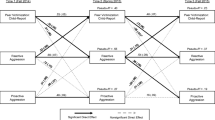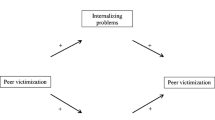Abstract
This longitudinal investigation examined interactions between aggression and peer victimization during middle childhood in the prediction of arrest through the adult years for 388 (198 boys, 190 girls) study participants. As part of an ongoing multisite study (i.e., Child Development Project), peer victimization and aggression were assessed via a peer nomination inventory in middle childhood, and juvenile and adult arrest histories were assessed via a self-report questionnaire as well as review of court records. Early aggression was linked to later arrest but only for those youths who were rarely victimized by peers. Although past investigators have viewed youths who are both aggressive and victimized as a high-risk subgroup, our findings suggest that the psychological and behavioral attributes of these children may mitigate trajectories toward antisocial problems.
Similar content being viewed by others

Notes
As noted earlier in this paper, terminology and conceptualization vary across studies. Insofar as appropriate, we will describe existing findings using the categories and terminology relied on by the original researchers.
References
Aiken, L. S., & West, S. G. (1991). Multiple regression: Testing and interpreting interactions. Newbury Park: Sage.
Barker, E. D., & Salekin, R. T. (2012). Irritable oppositional defiance and callous unemotional traits: Is the association partially explained by peer victimization? Journal of Child Psychology and Psychiatry, 53, 1167–1175.
Cillessen, A. H. N., & Mayeux, L. (2004). From censure to reinforcement: Developmental changes in the association between aggression and social status. Child Development, 75, 147–163.
Cook, C. R., Williams, K. R., Guerra, N. G., Kim, T. E., & Sadek, S. (2010). Predictors of bullying and victimization in childhood and adolescence: A meta-analytic investigation. School Psychology Quarterly, 25, 65–83.
Crick, N. R., & Grotpeter, J. K. (1995). Relational aggression, gender, and social-psychological adjustment. Child Development, 66, 710–722.
Dodge, K. A., & Pettit, G. S. (2003). A biopsychosocial model of the development of chronic conduct problems in adolescence. Developmental Psychology, 39, 349–371.
Dodge, K. A., Pettit, G. S., & Bates, J. E. (1994). Socialization mediators of the relation between socioeconomic status and child conduct problems. Child Development, 65, 649–665.
Graham, S., Bellmore, A., Nishina, A., & Juvonen, J. (2009). “It must be me”: Ethnic diversity and attributions for peer victimization in middle school. Journal of Youth and Adolescence, 38, 487–499.
Hollingshead, W. (1979). The Hollingshead four factor index of sociometric status. Yale University: Unpublished paper.
Huesmann, L. R., Eron, L. D., & Dubow, E. F. (2002). Childhood predictors of adult criminality: Are all risk factors reflected in childhood aggressiveness? Criminal Behaviour and Mental Health, 12, 185–208.
Ladd, G. W., & Kochenderfer-Ladd, B. (2002). Identifying victims of peer aggression from early to middle childhood: Analysis of cross-informant data for concordance, incidence of victimization, characteristics of identified victims, and estimation of relational adjustment. Psychological Assessment, 14, 74–96.
Lahey, B. B., Lee, S. S., Sibley, M. H., Applegate, B., Molina, B. S. G., & Pelham, W. E. (2016). Predictors of adolescent outcomes among 4–6-year-old children with attention-deficit/hyperactivity disorder. Journal of Abnormal Psychology, 125, 168–181.
Lereya, S. T., Copeland, W. E., Zammit, S., & Wolke, D. (2015). Bully/victims: A longitudinal, population-based cohort study of their mental health. European Child & Adolescent Psychiatry, 24, 1461–1471.
Low, S., Polanin, J. R., & Espelage, D. L. (2013). The role of social networks in physical and relational aggression among young adolescents. Journal of Youth and Adolescence, 42, 1078–1089.
Nansel, T. R., Overpeck, M., Pilla, R. S., Ruan, W. J., Simons-Morton, B., & Scheidt, P. (2001). Bullying behavior among U.S. youth: Prevalence and association with psychosocial adjustment. Journal of the American Medical Association, 285, 2094–2100.
Olweus, D. (1978). Aggression in the schools: Bullies and their whipping boys. Washington, DC: Hemisphere.
Olweus, D. (1993). Bullying at school: What we know and what we can do. Oxford and Cambridge: Blackwell Publishers.
Ostrov, J. M. (2010). Prospective associations between peer victimization and aggression. Child Development, 81, 1670–1677.
Patterson, G. R., Forgatch, M. S., Yoerger, K. L., & Stoolmiller, M. (1998). Variables that initiate and maintain an early-onset trajectory for juvenile offending. Development and Psychopathology, 10, 531–547.
Pellegrini, A. D., Bartini, M., & Brooks, F. (1999). School bullies, victims, and aggressive victims: Factors relating to group affiliation and victimization in early adolescence. Journal of Educational Psychology, 91, 216–224.
Perry, D. G., Kusel, S. J., & Perry, L. C. (1988). Victims of peer aggression. Developmental Psychology, 24, 807–814.
Perry, D. G., Perry, L. C., & Kennedy, E. (1992). Conflict and the development of antisocial behavior. In C. U. Shantz & W. W. Hartup (Eds.), Conflict in child and adolescent development (pp. 301–329). New York: Cambridge University Press.
Petersen, I. T., Bates, J. E., Dodge, K. A., Lansford, J. E., & Pettit, G. S. (2015). Describing and predicting developmental profiles of externalizing problems from childhood to adulthood. Development and Psychopathology, 27, 791–818.
Piquero, A. R., & Brame, R. W. (2008). Assessing the race–crime and ethnicity–crime relationship in a sample of serious adolescent delinquents. Crime and Delinquency, 54, 390–422.
Schwartz, D. (2000). Subtypes of victims and aggressors in children’s peer groups. Journal of Abnormal Child Psychology, 28, 181–192.
Schwartz, D., Dodge, K. A., Pettit, G. S., & Bates, J. E. (1997). The early socialization of aggressive victims of bullying. Child Development, 68, 665–675.
Schwartz, D., McFadyen-Ketchum, S. A., Dodge, K. A., Pettit, G. S., & Bates, J. E. (1998). Peer victimization as a predictor of behavior problems at home and in school. Development and Psychopathology, 10, 87–100.
Schwartz, D., McFadyen-Ketchum, S. A., Dodge, K. A., Pettit, G. S., & Bates, J. E. (1999). Early behavior problems as a predictor of later peer group victimization: Moderators and mediators in the pathways of social risk. Journal of Abnormal Child Psychology, 27, 191–201.
Schwartz, D., Dodge, K. A., Pettit, G. S., Bates, J. E., & the Conduct Problems Prevention Research Group. (2000). Friendship as a moderating factor in the pathway between early harsh home environment and later victimization in the peer group. Developmental Psychology, 36, 646–662.
Schwartz, D., Proctor, L. J., & Chien, D. (2001). The aggressive victim of bullying: Emotional and behavioral dysregulation as a pathway to victimization by peers. In J. Juvonen & S. Graham (Eds.), School-based peer harassment: The plight of the vulnerable and victimized (pp. 147–174). New York: The Guilford Press.
Schwartz, D., Gorman, A. H., Dodge, K. A., Pettit, G. S., & Bates, J. E. (2008a). Friendships with peers who are low or high in aggression as moderators of the link between peer victimization and declines in academic functioning. Journal of Abnormal Child Psychology, 36, 719–730.
Schwartz, D., Gorman, A. H., Duong, M. T., & Nakamoto, J. (2008b). Peer relationships and academic achievement as interacting predictors of depressive symptoms during middle childhood. Journal of Abnormal Psychology, 117, 289–299.
Schwartz, D., Lansford, J. E., Dodge, K. A., Pettit, G. S., & Bates, J. E. (2013). The link between harsh home environments and negative academic trajectories is exacerbated by victimization in the elementary school peer group. Developmental Psychology, 49, 305–316.
Schwartz, D., Lansford, J. E., Dodge, K. A., Pettit, G. S., & Bates, J. E. (2015). Peer victimization during middle childhood as a lead indicator of internalizing problems and diagnostic outcomes in late adolescence. Journal of Clinical Child and Adolescent Psychology, 44, 393–404.
Sourander, A., Jensen, P., Rönning, J. A., Niemelä, S., Helenius, H., Sillanmäki, L.,. .. Almqvist, F. (2007). What is the early adulthood outcome of boys who bully or are bullied in childhood? The Finnish "from a boy to a man" study. Pediatrics, 120, 397–404.
Sourander, A., Brunstein Klomek, A., Kumpulainen, K., Puustjärvi, A., Elonheimo, H., Ristkari, T.,. .. Ronning, J. A. (2011). Bullying at age eight and criminality in adulthood: Findings from the Finnish Nationwide 1981 birth cohort study. Social Psychiatry and Psychiatric Epidemiology, 46, 1211–1219.
Toblin, R. L., Schwartz, D., Gorman, A. H., & Abou-Ezzeddine, T. (2005). Social-cognitive and behavioral attributes of aggressive victims of bullying. Journal of Applied Developmental Psychology, 26, 329–346.
Wolke, D., Copeland, W. E., Angold, A., & Costello, E. J. (2013). Impact of bullying in childhood on adult health, wealth, crime, and social outcomes. Psychological Science, 24, 1958–1970.
Zych, I., Ttofi, M. M., & Farrington, D. P. (2016). Empathy and Callous–Unemotional Traits in Different Bullying Roles: A Systematic Review and Meta-Analysis. Trauma, Violence, & Abuse, 1-19. https://doi.org/10.1177/1524838016683456
Acknowledgements
The Child Development Project has been funded by grants MH56961, MH57024, and MH57095 from the National Institute of Mental Health, HD30572 from the Eunice Kennedy Shriver National Institute of Child Health and Human Development, and DA016903 from the National Institute on Drug Abuse.
Author information
Authors and Affiliations
Corresponding author
Ethics declarations
Conflict of Interest
The authors declare that they have no conflict of interest.
Ethical Approval
All procedures performed in studies involving human participants were in accordance with the ethical standards of the institutional and/or national research committee and with the 1964 Helsinki declaration and its later amendments or comparable ethical standards.
Informed Consent
Informed consent was obtained from all individual participants included in the study.
Rights and permissions
About this article
Cite this article
Schwartz, D., Lansford, J.E., Dodge, K.A. et al. Peer Victimization during Middle Childhood as a Marker of Attenuated Risk for Adult Arrest. J Abnorm Child Psychol 46, 57–65 (2018). https://doi.org/10.1007/s10802-017-0354-x
Published:
Issue Date:
DOI: https://doi.org/10.1007/s10802-017-0354-x



